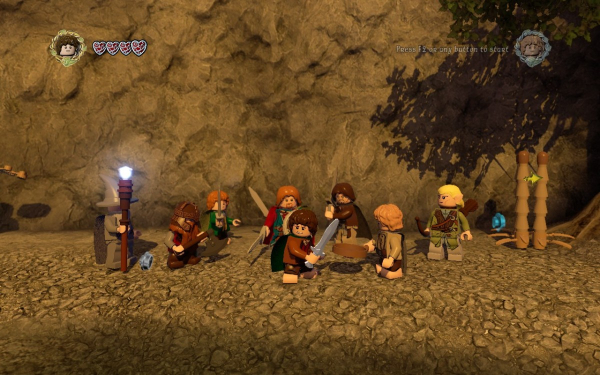Suche
Beiträge, die mit lego getaggt sind
New #review 310 - LEGO The Lord of the Rings
This week we drop back in on a LEGO game for the first time in a while with one of the landmark games in the franchise, The Lord of the Rings!
https://thealmightybacklog.wordpress.com/2024/11/20/lego-the-lord-of-the-rings/
#blog #blogging #videogames #gaming #lego #lotr
This week we drop back in on a LEGO game for the first time in a while with one of the landmark games in the franchise, The Lord of the Rings!
https://thealmightybacklog.wordpress.com/2024/11/20/lego-the-lord-of-the-rings/
#blog #blogging #videogames #gaming #lego #lotr

LEGO The Lord of the Rings
If you’ve been following the blog for a time you might have seen that I love a LEGO game every once in a while. I find that when you play a lot of longer or heavier games it really helps to know th…The Almighty Backlog
The Turing Machine made Real, In LEGO.
A working Turing Machine was submitted to Lego Ideas, consisting of approximately 2,900 parts and a bucketload of extreme cleverness. The original machine was devised by mathematician Alan Turing in 1936. Turing's idea was a hypothetical system that could simulate any computer algorithm.
https://youtu.be/8AA3E05axHw?si=MWCSLoUNAxo2TiWD
#turing #machine #history #retro #computing #lego #artist #it #engineer #media #tech #art #news
A working Turing Machine was submitted to Lego Ideas, consisting of approximately 2,900 parts and a bucketload of extreme cleverness. The original machine was devised by mathematician Alan Turing in 1936. Turing's idea was a hypothetical system that could simulate any computer algorithm.
https://youtu.be/8AA3E05axHw?si=MWCSLoUNAxo2TiWD
#turing #machine #history #retro #computing #lego #artist #it #engineer #media #tech #art #news


![[ImageSource: Bananaman 2018]
The design consisted of an infinitely long tape with symbols that could be moved left and right, a 'head' that could read the symbols and overwrite them with new ones, a finite control that described the machine's state, and a table to link each combination of state and symbol to an instruction for what to do next.
In addition to the constraints of making the device out of Lego, there was also the challenge of fitting into the limits imposed by Lego Ideas. At the time of submission, this was 3,000 parts and The Bananaman's contraption finally managed to come in at around 2,900. The limit has since been raised to 5,000 parts.
Fans of 3D printing will no doubt be pleased to note that some of the parts (notably one of the large gears) came from a printer, but only because buying missing bits online tends to take longer and cost more. A real-world version of the model was designed and built first to make sure it worked. [ImageSource: Bananaman 2018]
The design consisted of an infinitely long tape with symbols that could be moved left and right, a 'head' that could read the symbols and overwrite them with new ones, a finite control that described the machine's state, and a table to link each combination of state and symbol to an instruction for what to do next.
In addition to the constraints of making the device out of Lego, there was also the challenge of fitting into the limits imposed by Lego Ideas. At the time of submission, this was 3,000 parts and The Bananaman's contraption finally managed to come in at around 2,900. The limit has since been raised to 5,000 parts.
Fans of 3D printing will no doubt be pleased to note that some of the parts (notably one of the large gears) came from a printer, but only because buying missing bits online tends to take longer and cost more. A real-world version of the model was designed and built first to make sure it worked.](https://friendica-leipzig.de/photo/preview/600/254275)
![[ImageSource: 6zacl8.blogspot]
The original Alan Turing machine.
First demonstrated in 1950, this is one of Britain's earliest stored program computers and the oldest complete general purpose electronic computer in Britain. Designed and built at the National Physical Laboratory, Middlesex in 1949-1950, it was based on plans for a larger computer (the ACE) designed by the mathematician Alan Turing (1912-1954) at NPL between 1945 and 1947. Previously Turing worked on the Colossus computer used in codebreaking at Bletchley Park during World War II. Pilot ACE was estimated to have cost £50,000 to design and build, but by 1954 had earned over £240,000 from advanced scientific and engineering work in various fields including crystallography, aeronautics and computing bomb trajectories. [ImageSource: 6zacl8.blogspot]
The original Alan Turing machine.
First demonstrated in 1950, this is one of Britain's earliest stored program computers and the oldest complete general purpose electronic computer in Britain. Designed and built at the National Physical Laboratory, Middlesex in 1949-1950, it was based on plans for a larger computer (the ACE) designed by the mathematician Alan Turing (1912-1954) at NPL between 1945 and 1947. Previously Turing worked on the Colossus computer used in codebreaking at Bletchley Park during World War II. Pilot ACE was estimated to have cost £50,000 to design and build, but by 1954 had earned over £240,000 from advanced scientific and engineering work in various fields including crystallography, aeronautics and computing bomb trajectories.](https://friendica-leipzig.de/photo/preview/600/254277)
